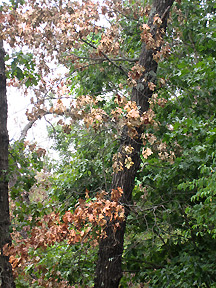At every turn we are seeing and hearing about how the drought of 2012 is causing economic distress by devastating crop yields, threatening forest fires and generally wreaking havoc in every quarter. Missouri, if you look at the latest drought map, seems to be the epicenter of this monstrous event that now affects most of the country and grows more severe with each passing day. Unfortunately, this drought is not an isolated event. It began in the summer of 2011 when we suffered through the hottest summer on record across most of the state. Rainfall during the winter was below average and the subsoil never had a chance to recharge with moisture, setting the stage for more stress this summer.

The fate of large established trees is the biggest concern in the landscape and urban forest. Summertime leaf drop during an extreme drought such as this is a good thing because it shows branches are still alive and capable of forming the abscission layer that permits the leaf to drop. With fewer leaves, less water is needed. Oftentimes when a limb defoliates early it will retain a whorl of leaves near the end of the branch, but sometimes even these youngest leaves will also be sacrificed.
In most cases trees that hold their leaves instead of dropping them are in serious decline or already dead. However, dogwoods use a different strategy for reducing leaf area. In this species leaves begin to burn from the tip and margins, leaving an ever-smaller wedge of green near the petiole (or stalk attaching the leaf blade to the stem). Though dogwoods may still retain their burned leaves when fall arrives, in most cases they will leaf out normally next spring. Dont be in a rush to remove trees that you may fear to be dead unless they present a safety hazard because some may surprise you come spring.
Watering old established trees once they show the first sign of wilt and or leaf drop may forestall further injury but catchup irrigation seldom is enough to change the course of events that the drought has already set in play. Tree roots radiate in all directions from the tree and extend out from the base in a circle approximately equal to the trees height. The often used trickling garden hose left running over night at the base of the tree does little good because most water uptake is done by the smaller feeder roots further from the trunk. A sprinkler left running for several hours will do more good for the tree. Ideally a tree should have 1 to 1.5 inches of water per week but this late into the drought dont expect much visible results from your efforts this growing season.
Recently planted trees also need extra care during drought conditions. Because the roots are confined to a smaller area than established trees extra care must be used to keep the root ball moist. A generous layer of mulch will help mediate soil moisture and keep the soil cooler. Young trees often suffer from bark scald if the trunk is exposed to the sun during the day. Water movement through the trunk is often reduced during the heat of the day when the leaves give off more moisture than the roots can take up. Most of the cooling of thin barked tree trunks occurs by means of water passing through the xylem vessels and carrying away the excess heat. When sap flow slows, the trunks get hotter and can reach 140 degrees F or more if the sun strikes the trunk at an acute angle. These temperatures are lethal and will kill a strip of bark on the southwest side of the trunk. Wrap the trunk in burlap, tin foil or a specially designed tree wrap to guard against this injury.
The University of Arkansas contributed to this report.






Comments